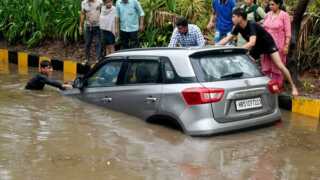Share via:
- Essential tips to drive in the rains include avoiding deep water, ensuring vehicle readiness and using fog lamps for visibility.
…Read More Driving in the rain requires extra caution, especially on flooded roads. View Personalised Offers on Check Offers The monsoon may have finally provided relief from the scorching summer sun, but it has also brought new problems to India’s roads. The rain not only promises cooler weather but also bumper to bumper traffic jams, long stretches of water-logged roads, and the increasing probability of your car breaking down when you definitely do not want it to. Delhi, Mumbai, and several other cities are already reporting flooded roads, and anyone who has ever attempted to wade through them in a car knows the cost can be steep — from stalled engines to electrical damage. And beyond the repair bill, there’s the very real question of safety. Which is why a little caution goes a long way. Monsoon driving is not about bravado; it’s about knowing when to pause. Sometimes the smartest move is the simplest one: if the water looks deep, don’t risk it. Park it out. Better to wait than to gamble with your car and your own safety. Here are a few practical checks and habits that can help you stay ahead of the rain and keep both you and your vehicle out of harm’s way: Avoid waterlogged roadsIf you see a stretch of road submerged in water, take a different route, even if it’s a longer one. Driving through deep water can lead to engine hydrostatic lock, a costly issue that occurs when water enters the engine. Know your vehicle’s wading depthEvery car has a limit to how much water it can safely wade through, known as the wading depth. For hatchbacks and sedans, this is usually around 300mm. SUVs can go slightly deeper (up to 500–600mm), but even then, caution is key. Check your car’s manual or the manufacturer’s website for accurate information. Maintain a steady speedIf you absolutely must cross a waterlogged area, do so at a steady, slow pace in first gear, keeping the engine revs up. Avoid sudden acceleration or braking, which can splash water into the engine bay or cause loss of control. Turn off the ACSwitching off your AC helps reduce the load on the engine. Also, keep the windows slightly open to prevent fogging and ensure visibility. Avoid cranking a submerged engineIf your car stalls in water, do not attempt to restart it immediately. Starting a waterlogged engine can cause permanent internal damage. Instead, call for roadside assistance or a towing service. Use hazard lights and fog lampsVisibility during heavy rain or in low-lying flooded areas can drop drastically. Turn on your fog lamps and hazard lights to make your vehicle more visible to others. Dry your brakes after exiting waterAfter you cross a flooded road, lightly tap the brake pedal while driving slowly. This helps dry the brake pads and restores braking efficiency. Keep tyres properly inflatedUnder-inflated tyres increase the risk of aquaplaning, where the car loses traction and control on wet surfaces. Make sure your tyres have enough tread depth and correct pressure before heading out. Get monsoon-proof accessoriesUse rubber floor mats, waterproof car seat covers, and door visors to protect your interiors from muddy water and moisture. A car body cover can protect the exterior if you park in open areas. Service and inspect electrical systemsMoisture can cause major issues in the car’s electrical systems, especially in older vehicles. Ensure your battery, wiring, fuses, and lights are in top shape. Anti-rust coating for underbody protection is also advisable. Additionally, it is always useful to have a working GPS and an emergency contact app on your mobile device. This helps you find alternative routes and connect to assistance quickly if you get stranded. Stay safe, drive smart and tackle flooded routes responsibly! Get insights into Upcoming Cars In India, Electric Vehicles, Upcoming Bikes in India and cutting-edge technology transforming the automotive landscape. First Published Date: 27 May 2025, 14:30 pm IST
Source: hindustantimes.com






